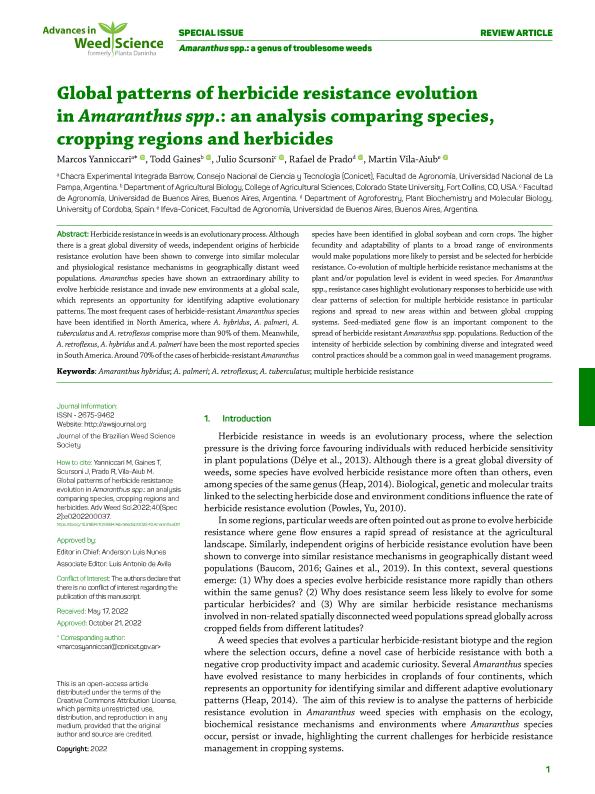Mostrar el registro sencillo del ítem
dc.contributor.author
Yanniccari, Marcos Ezequiel

dc.contributor.author
Gaines, Todd
dc.contributor.author
Scursoni, Julio Alejandro

dc.contributor.author
De Prado, Rafael

dc.contributor.author
Vila Aiub, Martin Miguel

dc.date.available
2023-10-12T12:11:52Z
dc.date.issued
2022-12
dc.identifier.citation
Yanniccari, Marcos Ezequiel; Gaines, Todd; Scursoni, Julio Alejandro; De Prado, Rafael; Vila Aiub, Martin Miguel; Global patterns of herbicide resistance evolution in Amaranthus spp.: an analysis comparing species, cropping regions and herbicides; Brazilian Weed Science Society; Advances in Weed Science; 40; spe2; 12-2022; 1-14
dc.identifier.issn
2675-9462
dc.identifier.uri
http://hdl.handle.net/11336/214986
dc.description.abstract
Herbicide resistance in weeds is an evolutionary process. Although there is a great global diversity of weeds, independent origins of herbicide resistance evolution have been shown to converge into similar molecular and physiological resistance mechanisms in geographically distant weed populations. Amaranthus species have shown an extraordinary ability to evolve herbicide resistance and invade new environments at a global scale, which represents an opportunity for identifying adaptive evolutionary patterns. The most frequent cases of herbicide-resistant Amaranthus species have been identified in North America, where A. hybridus, A. palmeri, A. tuberculatus and A. retroflexus comprise more than 90% of them. Meanwhile, A. retroflexus, A. hybridus and A. palmeri have been the most reported species in South America. Around 70% of the cases of herbicide-resistant Amaranthus species have been identified in global soybean and corn crops. The higher fecundity and adaptability of plants to a broad range of environments would make populations more likely to persist and be selected for herbicide resistance. Co-evolution of multiple herbicide resistance mechanisms at the plant and/or population level is evident in weed species. For Amaranthus spp., resistance cases highlight evolutionary responses to herbicide use with clear patterns of selection for multiple herbicide resistance in particular regions and spread to new areas within and between global cropping systems. Seed-mediated gene flow is an important component to the spread of herbicide resistant Amaranthus spp. populations. Reduction of the intensity of herbicide selection by combining diverse and integrated weed control practices should be a common goal in weed management programs.
dc.format
application/pdf
dc.language.iso
eng
dc.publisher
Brazilian Weed Science Society
dc.rights
info:eu-repo/semantics/openAccess
dc.rights.uri
https://creativecommons.org/licenses/by-nc-sa/2.5/ar/
dc.subject
A. PALMERI
dc.subject
A. RETROFLEXUS
dc.subject
A. TUBERCULATUS
dc.subject
A. HYBRIDUS
dc.subject
MULTIPLE HERBICIDE RESISTANCE
dc.subject.classification
Agronomía, reproducción y protección de plantas

dc.subject.classification
Agricultura, Silvicultura y Pesca

dc.subject.classification
CIENCIAS AGRÍCOLAS

dc.title
Global patterns of herbicide resistance evolution in Amaranthus spp.: an analysis comparing species, cropping regions and herbicides
dc.type
info:eu-repo/semantics/article
dc.type
info:ar-repo/semantics/artículo
dc.type
info:eu-repo/semantics/publishedVersion
dc.date.updated
2023-07-28T10:28:28Z
dc.journal.volume
40
dc.journal.number
spe2
dc.journal.pagination
1-14
dc.journal.pais
Brasil

dc.description.fil
Fil: Yanniccari, Marcos Ezequiel. Consejo Nacional de Investigaciones Científicas y Técnicas; Argentina
dc.description.fil
Fil: Gaines, Todd. University of Colorado; Estados Unidos
dc.description.fil
Fil: Scursoni, Julio Alejandro. Universidad de Buenos Aires. Facultad de Agronomía; Argentina
dc.description.fil
Fil: De Prado, Rafael. Universidad de Córdoba; España
dc.description.fil
Fil: Vila Aiub, Martin Miguel. Consejo Nacional de Investigaciones Científicas y Técnicas. Oficina de Coordinación Administrativa Parque Centenario. Instituto de Investigaciones Fisiológicas y Ecológicas Vinculadas a la Agricultura. Universidad de Buenos Aires. Facultad de Agronomía. Instituto de Investigaciones Fisiológicas y Ecológicas Vinculadas a la Agricultura; Argentina
dc.journal.title
Advances in Weed Science
dc.relation.alternativeid
info:eu-repo/semantics/altIdentifier/url/https://awsjournal.org/article/global-patterns-of-herbicide-resistance-evolution-in-amaranthus-spp-an-analysis-comparing-species-cropping-regions-and-herbicides/
dc.relation.alternativeid
info:eu-repo/semantics/altIdentifier/doi/http://dx.doi.org/10.51694/10.51694/AdvWeedSci/2022;40:Amaranthus011
Archivos asociados
